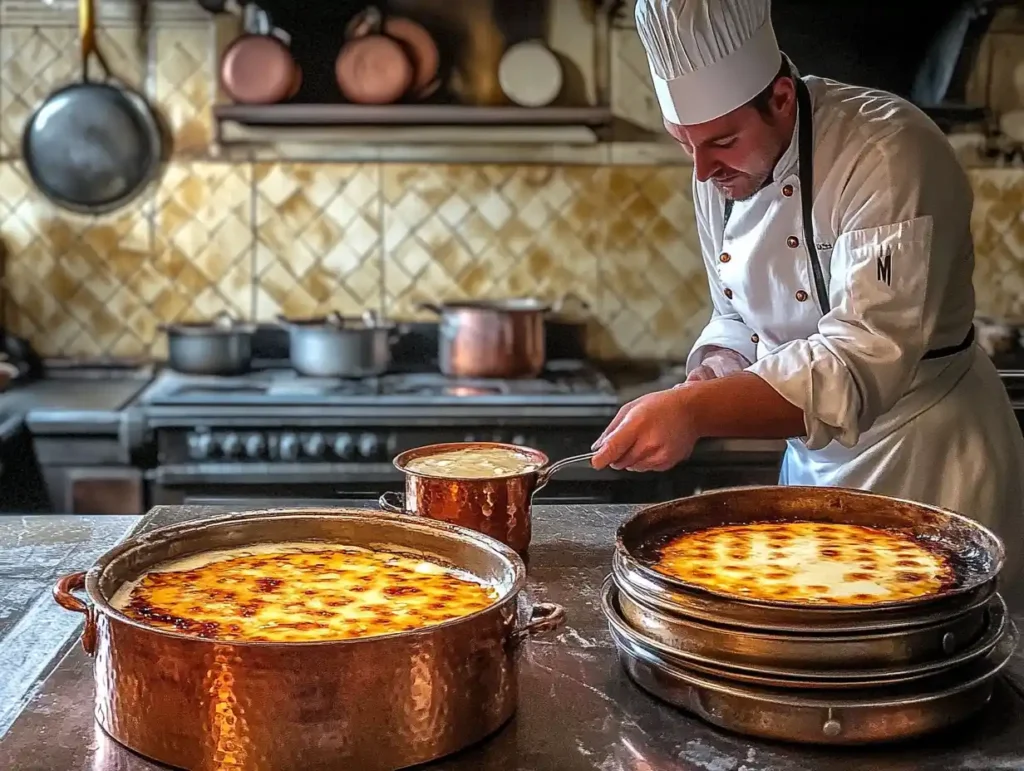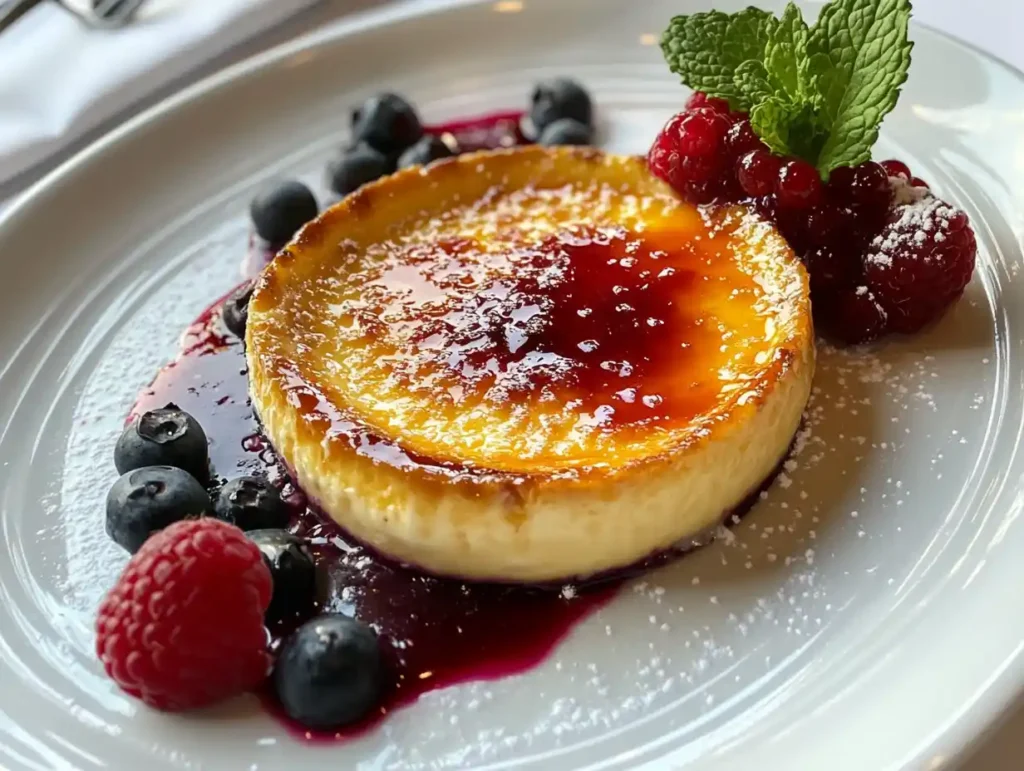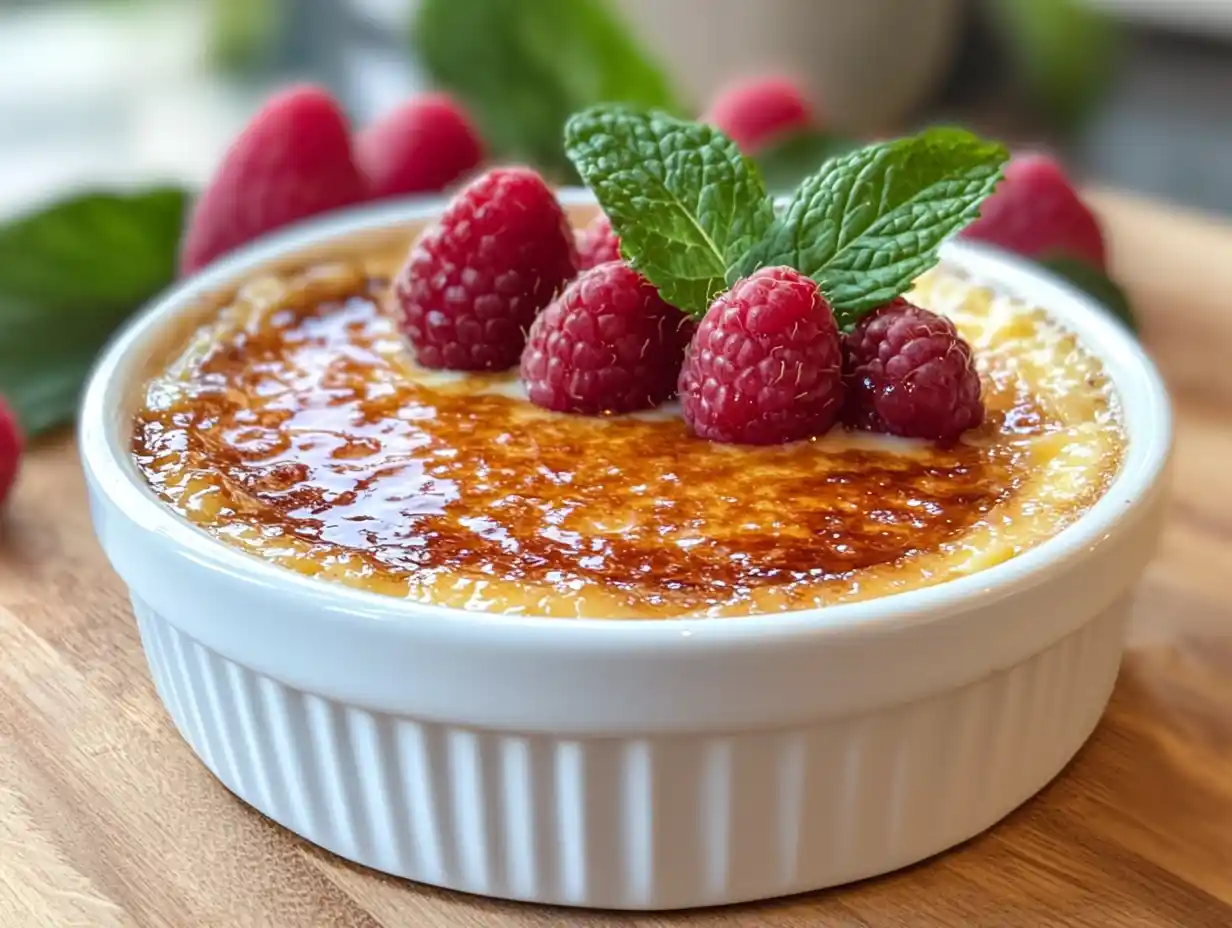Introduction
Crème brûlée is a timeless dessert beloved for its silky custard base and its signature caramelized sugar crust. While its name is French, meaning “burnt cream,” the dessert’s appeal transcends borders, gracing the menus of fine dining establishments and home kitchens alike. What makes crème brûlée so enchanting is not only its luxurious flavor but also its simplicity. At its core, this dessert is crafted from just a handful of ingredients, each playing a pivotal role in creating its unique texture and taste. This article explores what crème brûlée is mostly made of, its preparation, variations, and why it continues to captivate dessert lovers around the world.
The Origins of Crème Brûlée
Historical Background

Crème brûlée has a rich and somewhat debated history. Its origins are commonly traced back to France, where the dessert first appeared in culinary literature in the 17th century. However, similar dishes have been noted in England and Spain. For example, the English version, known as “Trinity Cream,” was served at Trinity College in Cambridge, distinguished by the college crest caramelized into the sugar topping. Meanwhile, Spain offers “Crema Catalana,” a custard dessert flavored with citrus and cinnamon, which predates the French rendition.
Regardless of its origins, crème brûlée has cemented itself as a classic dessert, celebrated for its balance of creamy custard and crisp caramelized sugar.
Popularity Through the Ages
Over the centuries, crème brûlée evolved from being a rare delicacy for the wealthy to a staple on restaurant menus worldwide. Its revival in the 1980s, particularly in the United States, coincided with a growing fascination with French cuisine. Today, it remains a symbol of culinary elegance and is often featured in both traditional and experimental forms.
Core Ingredients of Crème Brûlée
Heavy Cream: The Luxurious Base
The foundation of crème brûlée lies in its rich and velvety texture, primarily achieved through heavy cream. This ingredient not only provides the dessert’s luxurious mouthfeel but also allows the custard to set properly. For the best results, fresh, high-fat cream is typically preferred, as it imparts a depth of flavor and ensures a smooth consistency.
Egg Yolks: The Custard Component
Egg yolks are crucial in transforming the cream into a thick and stable custard. Their proteins coagulate during the baking process, giving the dessert its characteristic structure. In addition, the yolks add a natural richness and a slightly golden hue, enhancing the visual and taste appeal of the dish.
Sugar: Sweetness and Caramelization
Sugar serves a dual purpose in crème brûlée. Mixed into the custard, it delivers sweetness and balances the richness of the cream and eggs. More importantly, a thin layer of sugar is sprinkled on top and caramelized using a kitchen torch or broiler. This creates the iconic brittle crust that contrasts beautifully with the creamy custard below.
Vanilla: The Signature Flavor
Vanilla is the heart of the flavor profile in classic crème brûlée. Whether it’s a pod of real vanilla beans or a high-quality extract, this ingredient provides a fragrant, sweet aroma that elevates the dessert to its iconic status. Vanilla beans, in particular, contribute specks of seeds, adding a visual touch of sophistication.
Optional Ingredients and Variations
Flavor Enhancements
While traditional crème brûlée is flavored primarily with vanilla, modern variations incorporate other ingredients to diversify its taste. Citrus zest, such as orange or lemon, can brighten the custard, adding a refreshing tang. Chocolate, coffee, or liqueurs like Grand Marnier and Amaretto are also popular for creating unique flavor profiles. Seasonal fruits, such as berries or mangoes, may be layered beneath the custard to add natural sweetness and color.
Dairy Alternatives for Special Diets
For those with dietary restrictions, crème brûlée can be adapted using dairy-free alternatives. Coconut milk, almond milk, or oat cream are excellent substitutes for heavy cream, offering different textures and flavors. Similarly, plant-based sweeteners, such as agave syrup or stevia, can replace sugar. Though these variations may alter the traditional richness, they enable more people to enjoy this classic dessert.
How Crème Brûlée Is Made
Step-by-Step Preparation Process
Making this iconic dessert at home is a rewarding experience that involves a few simple steps:
- Prepare the Custard Base: Combine heavy cream, sugar, and vanilla in a saucepan. Heat gently until warm but not boiling. In a separate bowl, whisk the egg yolks. Slowly temper the yolks by adding the warm cream mixture gradually, ensuring the eggs do not curdle.
- Bake the Custard: Pour the mixture into ramekins and place them in a baking dish filled with hot water, creating a bain-marie. This ensures even cooking and prevents the custard from cracking. Bake at a low temperature until the custard sets with a slight jiggle in the center.
- Cool and Refrigerate: Let the custards cool at room temperature before refrigerating for several hours, allowing them to firm up further.
Tips for Perfecting the Custard Texture
To achieve a silky-smooth texture:
- Strain the custard mixture through a fine sieve before pouring it into ramekins.
- Avoid overbaking; the custard should wobble slightly in the center when removed from the oven.
- Use fresh, high-quality ingredients for optimal flavor and consistency.
Achieving the Iconic Sugar Crust
The hallmark of crème brûlée is its caramelized sugar topping. To perfect this:
- Sprinkle an even layer of granulated sugar over the chilled custard.
- Use a kitchen torch to melt the sugar evenly, creating a golden-brown crust. If you don’t have a torch, broil the ramekins on high for a few minutes, keeping a close eye to prevent burning.
- Allow the crust to cool for a minute, forming a crackly surface that shatters with a spoon.
Nutritional Value
Calories and Macronutrient Breakdown
Crème brûlée is a rich dessert, with its caloric content primarily derived from the heavy cream, sugar, and egg yolks. A typical serving (about 4 oz) contains approximately:
- Calories: 250-350
- Protein: 5-6 grams
- Fat: 20-25 grams (mostly saturated fats from the cream and eggs)
- Carbohydrates: 20-25 grams (mainly from the sugar).
While it’s indulgent, the dessert also provides small amounts of essential nutrients like vitamin D, calcium, and phosphorus from the dairy and eggs. However, its high calorie and fat content make it a treat best enjoyed in moderation.
Adapting Recipes for Healthier Options
For those looking to enjoy crème brûlée with fewer calories:
- Substitute heavy cream with lighter options, such as half-and-half or low-fat milk.
- Use natural sweeteners like honey or coconut sugar, which have a lower glycemic index.
- Experiment with smaller serving sizes to reduce calorie intake while still indulging in the luxurious flavors.
Serving and Presentation

Traditional Ways to Serve Crème Brûlée
Crème brûlée is traditionally served in shallow, round ramekins that allow for a perfect balance of custard and caramelized topping. The dessert is often served chilled, with the contrasting textures of the creamy custard and crunchy sugar crust creating an unforgettable experience.
Creative Garnishes and Pairings
For an elevated presentation, consider these garnishing ideas:
- Fruit Toppings: Fresh berries, sliced kiwi, or edible flowers add color and a burst of freshness.
- Spices and Herbs: A sprinkle of cinnamon, nutmeg, or a sprig of mint can enhance both flavor and aesthetics.
- Accompaniments: Pair crème brûlée with a side of shortbread cookies or a drizzle of fruit coulis for an extra layer of indulgence.
Why Crème Brûlée Remains Iconic
Cultural Significance in Cuisine
Crème brûlée is more than just a dessert; it represents sophistication and the artistry of French cuisine. Its presence on a menu often signals a restaurant’s dedication to tradition and quality. The dessert has also become a symbol of celebration, frequently served at weddings, anniversaries, and other special occasions.
Modern Twists and Trends
Chefs worldwide have reinvented crème brûlée to keep it relevant in contemporary cuisine. Variations include savory versions made with ingredients like foie gras or truffle, as well as experimental presentations like crème brûlée-filled doughnuts or layered parfaits. These innovations showcase the dessert’s versatility and timeless appeal.
Frequently Asked Questions
Is crème brûlée gluten-free?
Yes, traditional crème brûlée is naturally gluten-free. The core ingredients—heavy cream, egg yolks, sugar, and vanilla—do not contain gluten. However, if any additional flavorings or toppings are added, it’s essential to verify that they are gluten-free as well.
Can you use milk instead of heavy cream?
While heavy cream is traditional for its rich texture, milk can be used as a substitute for a lighter version of crème brûlée. Whole milk or a mixture of milk and cream works best, but the custard will be less creamy and slightly less stable.
How do you get a perfect caramelized top?
To achieve a perfect caramelized sugar crust:
- Use an even layer of granulated sugar on the chilled custard.
- Hold a kitchen torch a few inches away and move it in circular motions to evenly melt and caramelize the sugar.
- Allow the sugar to cool briefly to form a brittle crust before serving.
What is the difference between crème brûlée and custard?
While crème brûlée belongs to the custard family, its caramelized sugar topping sets it apart. Other custards, like flan or pots de crème, lack this feature and often come with different toppings, such as caramel sauce or fruit.
Can crème brûlée be made ahead of time?
Yes, crème brûlée is an excellent make-ahead dessert. The custard can be prepared, baked, and refrigerated for up to 2-3 days. Caramelize the sugar topping just before serving to maintain its crisp texture.
Why is my crème brûlée runny?
Underbaking usually causes runny crème brûlée. Check that the custard has a slight jiggle in the center before you take it out of the oven. Adding a water bath (bain-marie) helps you achieve an even, creamy texture.
Related Recipes and Tips
- What Is the Secret to Crème Brûlée? Expert Tips Revealed – Learn the key steps for mastering this dessert.
- Vanilla Bean Paste: Everything You Need to Know – Discover the importance of vanilla in crafting perfect Crème Brûlée.
- Lemon Blueberry Cookies: A Delightful Treat for Every Occasion – A complementary sweet treat to serve alongside Crème Brûlée.
These articles will enhance your dessert-making skills and inspire more culinary creativity!
Conclusion
Crème brûlée remains one of the most celebrated desserts, beloved for its perfect harmony of creamy custard and crisp caramelized sugar. Its simplicity lies in the handful of core ingredients—heavy cream, egg yolks, sugar, and vanilla—that come together to create a dessert that is both elegant and indulgent. With countless variations and modern twists, crème brûlée continues to captivate dessert lovers across cultures and generations. Whether you enjoy it in its classic form or experiment with flavors and presentations, this timeless treat is a true testament to the artistry of culinary tradition.
